Fish Diets Boost Kids' Social Skills: A Parent Guide

Boost your child's social skills with a fish-rich diet. Discover expert tips, recipes, and safe fish choices to nurture healthy brain growth.
Introduction
The journey of childhood is filled with milestones, from first steps to first words. Among these, the development of social skills stands out as a cornerstone for a child's happiness, confidence, and future success. Learning to make friends, navigate the complexities of the schoolyard, understand others' feelings, and communicate effectively are all vital parts of growing up. It's natural for parents and caregivers to wonder how best to support this intricate development. While loving guidance and ample opportunities for interaction are key, emerging science suggests another powerful ally: nutrition. Could something as fundamental as the food a child eats play a significant role in honing these crucial social abilities? Specifically, could incorporating more fish into their diet help children connect better with others and navigate their social worlds with greater ease? This guide explores the fascinating connection between fish consumption, brain development, and children's social skills, offering practical, parent-friendly advice to help little ones truly shine.
The Brainy Bites: Understanding Omega-3s and Your Child's Developing Mind
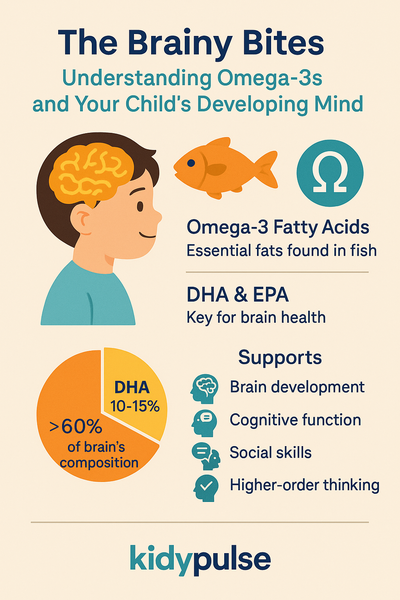
At the heart of the discussion about fish and its benefits for children are remarkable nutrients known as omega-3 fatty acids. These are not just any fats; they are "essential" fatty acids, meaning the human body cannot produce them on its own. Therefore, they must be obtained through diet. Among the various types of omega-3s, two stand out for their profound impact on brain health: docosahexaenoic acid, or DHA, and eicosapentaenoic acid, or EPA. These are abundantly found in fish, particularly oily varieties.
The connection between these fatty acids and brain development is deeply structural and functional. Consider this: over 60% of the brain is composed of fat, and DHA alone accounts for approximately 10-15% of this. This makes DHA a critical building block, quite literally shaping the brain. The period from birth up to about two years of age marks the brain's most rapid growth phase, though its development and refinement continue throughout childhood and adolescence. This extended developmental window underscores the importance of consistent omega-3 intake, not just in the very early years but as children continue to grow and learn. Children rely heavily on these essential fatty acids for visual, brain, and immune system development, as well as for normal emotional and cognitive function, from their prenatal stages right through to adolescence.
DHA is particularly crucial for the development of the sensory, perceptual, cognitive, and motor neural systems during the brain's growth spurt. These systems are the very foundation upon which social interactions are built. For instance, interpreting a friend's facial expression (perceptual system), understanding spoken language (cognitive system), and responding with appropriate gestures (motor system) all rely on well-developed neural pathways. Furthermore, DHA plays a key role in improving the fluidity of brain cell membranes. This enhanced fluidity means that nerve impulses, or the messages whizzing around in the brain, are transmitted more effectively. Imagine it as upgrading the brain's internal communication network from a dial-up connection to high-speed broadband. This improved efficiency in neural messaging is not just about general intelligence; it translates directly to the speed and efficiency with which a child can process social cues, formulate responses, and adapt in dynamic social environments. The parts of the brain rich in DHA are thought to be responsible for higher-order functions such as planning, problem-solving, and focused attention – all skills that are indispensable for successful social engagement and navigating peer relationships.
The importance of DHA is not confined to the initial, intense structural building phase of early childhood. The continued development of the brain through adolescence means that omega-3s remain vital for ongoing functional support and the refinement of these crucial neural pathways. Thus, a consistent supply of these "good fats" supports the brain's evolving needs, ensuring it has the resources for both foundational construction and sustained operational excellence.
Hook, Line, and Thinker: The Science Linking Fish to Better Social Skills
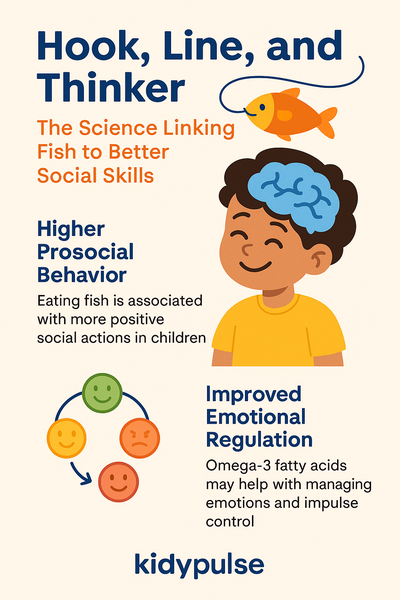
The notion that eating fish could influence a child's social interactions might seem surprising, but scientific research is beginning to uncover compelling links. One notable piece of research is the "Children of the 90s" study conducted at the University of Bristol. This extensive, long-term project followed a large group of children, providing valuable data on various aspects of their development. The study found that children who consumed the least amounts of seafood at 7 years old were more likely to exhibit fewer "prosocial" behaviors at both 7 and 9 years of age compared to their peers who regularly included seafood in their diets.
"Prosocial" behavior encompasses a range of positive social actions, including friendly interactions, sharing, altruism, and cooperation. These are the very behaviors that help children build positive relationships and integrate successfully into social groups. Importantly, the researchers in the "Children of the 90s" study found this association between lower fish intake and reduced prosocial behavior even after accounting for various other social and demographic factors. This suggests a more direct relationship between seafood consumption and the development of these desirable social traits. While prosocial behaviors begin to emerge when children are between 1 and 2 years old and generally grow in frequency and complexity as they age , the findings at ages 7 and 9 indicate that nutrition continues to play an influential role in the maintenance and further development of these complex social skills, well beyond their initial appearance. This offers an encouraging perspective, suggesting that dietary improvements can support social development even in older children.
Beyond general sociability, omega-3 fatty acids, particularly DHA and EPA, are increasingly recognized for their role in emotional well-being, which is intrinsically linked to social success. These fatty acids are not just for "smarts"; they are crucial for emotional regulation. Research suggests that omega-3s may support emotional balance by helping to regulate neurotransmitters in the brain, such as serotonin, which is often associated with feelings of happiness and well-being. When children can manage their emotions more effectively, they are better equipped to handle the ups and downs of social interactions.
Studies have indicated that children who regularly consume omega-3 supplements tend to respond with less aggression and exhibit greater self-control. These attributes are vital for positive peer interactions and forming stable friendships. Conversely, a deficiency in omega-3s has been linked to challenges such as emotional instability, difficulty focusing, and impulsive behavior. Each of these can create significant hurdles in a child's social life. For example, a child who struggles with impulsivity might interrupt frequently or act without thinking, potentially leading to social friction. Improved emotional regulation and impulse control, supported by adequate omega-3 intake, don't just mean fewer tantrums or outbursts; they directly contribute to a child being perceived by peers as more predictable, approachable, and enjoyable to be around. This, in turn, can foster more positive social experiences and pave the way for stronger, more meaningful friendships, illustrating an important indirect pathway through which nutrition can bolster social skills.
More Than Just Mingling: Other Big Wins from a Fish-Rich Diet
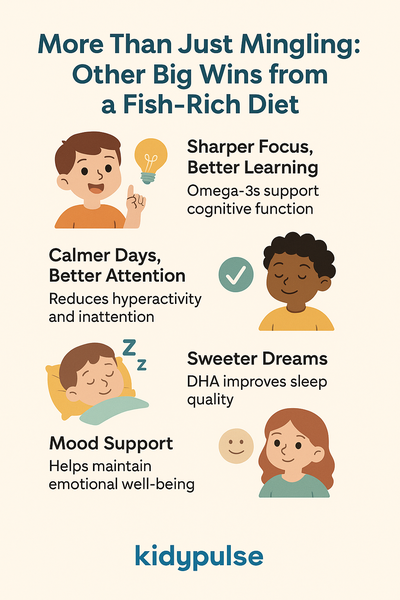
While the emerging connection to social skills is compelling, the benefits of a diet rich in fish and omega-3s extend to many other areas of a child's development, creating a cascade of positive effects. These interconnected advantages further underscore the value of these vital nutrients.
- Sharper Focus, Better Learning: Omega-3s, especially DHA, are well-established supporters of cognitive function. Studies indicate that DHA supports normal IQ and preserves learning and memory capabilities. Research reviews have found that DHA supplementation often leads to improved school performance, including enhancements in learning ability, reading, and spelling. For instance, the DOLAB study, which provided children with 600mg of omega-3 daily for four months, found that children in the bottom 20% for literacy boosted their reading age by three weeks more than the placebo group, and those in the bottom 10% saw an improvement of 1.9 months. Another study in Bradford reported that daily omega-3 fish oil supplementation resulted in 81% of pupils showing improvement in reading, 67% in writing, and 74% in Maths.
- Calmer Days, Better Attention (Especially for ADHD): For children who struggle with attention and hyperactivity, particularly those with(https://kidypulse.com/us/blog/physcological), omega-3s may offer significant support. Research is increasingly showing that supplementation with fish oil can reduce ADHD-related symptoms, including hyperactivity, inattention, and impulsivity, often with no adverse reactions. It's noteworthy that children diagnosed with ADHD often have lower blood levels of omega-3s compared to their peers without the disorder – on average, 38% lower according to one analysis. One study even found that children with ADHD and low levels of omega-3s exhibited poorer "emotion processing" and emotion regulation.
- Sweeter Dreams: Adequate sleep is crucial for a child's mood, learning, and overall well-being, all of which impact social interactions. The same DOLAB study that looked at literacy also investigated sleep. The findings were significant: poor sleep was associated with lower blood levels of DHA. Supplementation with DHA led to a reduction in nighttime disturbances and, remarkably, an average of 58 minutes more sleep per night.
- Mood Support: Beyond general emotional regulation, omega-3s are being explored for their potential role in addressing more significant mood challenges. While much of the research has focused on adults, depression in children is becoming more common. A controlled, double-blind pilot study in Israel examining children aged 6-12 with major depression found that the majority of those taking an omega-3 supplement experienced 50% fewer symptoms, with several achieving complete remission.
These diverse benefits are not isolated from a child's social development. A child who sleeps better is likely to be less irritable and more engaged during social play. A child who can focus more effectively is better able to follow conversations and understand social cues. Similarly, a child with a more stable mood is more likely to have positive interactions with peers. This creates a positive feedback loop: as these foundational areas improve with adequate omega-3 intake, a child is inherently better equipped to engage positively in social situations, further enhancing their social skills and confidence. This holistic impact highlights how a single dietary strategy can contribute to widespread improvements in a child's life.
Casting Your Net: Choosing the Best and Safest Fish for Your Child

Encouraging children to eat more fish is a positive step, but it's natural for parents to have questions about which types of fish are best and safest. Concerns about pollutants, such as mercury, are valid and have sometimes led to conflicting advice, making it difficult for parents to know the best course of action. However, the good news is that by making informed choices, families can reap the nutritional benefits of fish while minimizing potential risks. Many types of fish are both rich in beneficial omega-3s and low in mercury.
The key is to select a variety of fish, prioritizing those that are known to be lower in mercury. This approach not only minimizes exposure to any single potential contaminant but also ensures a broader range of micronutrients that different fish species offer.
Here’s a guide to help navigate the choices, based on advice from authorities like the U.S. Food and Drug Administration (FDA) and Environmental Protection Agency (EPA):
- Superstar Fish for Your Little One (Low Mercury, High Goodness! – "Best Choices"): These fish are excellent sources of omega-3s and are low in mercury, making them ideal for regular consumption. Aim to include these often:
- Salmon (a top source of DHA)
- Canned light tuna (includes skipjack – an easy and affordable option)
- Atlantic mackerel (note: distinct from King mackerel, which is high in mercury)
- Sardines (tiny powerhouses of omega-3s)
- Pollock
- Cod
- Herring
- Freshwater Trout
- Other "Best Choices" include: anchovies, catfish, clams, crab, crawfish, flounder, haddock, mullet, oysters, plaice.
- Good Choices (Enjoy in Moderation): These fish are still good sources of nutrients but may have slightly higher mercury levels than the "Best Choices." They can be part of a healthy diet but consumed less frequently:
- Canned albacore/white tuna (limit intake compared to light tuna due to higher mercury)
- Halibut
- Snapper
- Other "Good Choices" include: bluefish, carp, grouper, mahi mahi, monkfish, Chilean sea bass.
- Fish to Approach with Caution or Avoid (Highest Mercury Levels): These fish tend to accumulate higher levels of mercury and should generally be avoided by children, as well as by those who are pregnant or breastfeeding:
- Shark
- Swordfish
- King mackerel
- Tilefish (from the Gulf of Mexico; Atlantic tilefish is a "Good Choice")
- Orange roughy
- Bigeye tuna (often found in sushi)
- Marlin.
By directly addressing the concern about mercury with clear, authoritative guidance, the aim is to empower parents to overcome any hesitation and confidently incorporate these beneficial foods into their family's meals.
How Much is Enough? Serving Size Guidelines: Health authorities like the UK's National Health Service (NHS) generally recommend that children consume at least two portions of fish per week, with one of these portions being an oily fish (like salmon, mackerel, or sardines) due to their higher omega-3 content.
The FDA provides age-specific serving size recommendations for children, focusing on choices from the "Best Choices" list:
- Little Eaters (Ages 1-3 years): Aim for about 1 ounce per serving, two times a week.
- Growing Kids (Ages 4-7 years): Offer about 2 ounces per serving, two times a week.
- Older Children (Ages 8-10 years): A serving is about 3 ounces, two times a week.
- Pre-teens and Teens (Age 11+ years): A serving is about 4 ounces, two times a week.
To help visualize these amounts, a serving size for an adult is about 4 ounces, or roughly the size of the palm of an adult's hand. For children, adjust this visual to their smaller palm size. Fish can be introduced as soon as a baby starts solid foods, typically around 6 months, provided it's prepared safely (cooked thoroughly, deboned, and pureed or minced).
Making Fish a Splash Hit: Tips, Tricks, and Kid-Approved Ideas
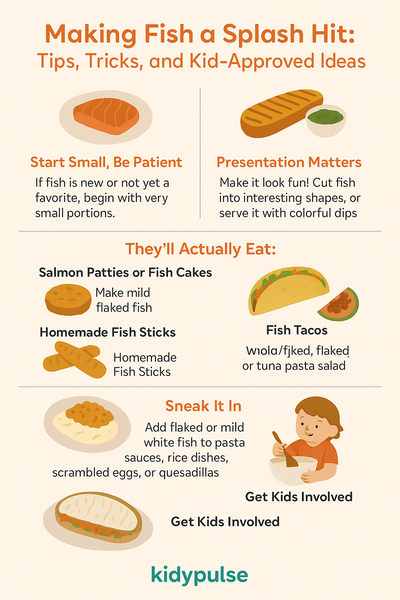
Knowing which fish to choose and how much to serve is one thing; getting children to actually eat it can be another adventure entirely. Many children can be hesitant about new flavors or textures, and fish can sometimes fall into that category. The key is often patience, creativity, and making the experience positive.
Here are some strategies and ideas to help make fish a welcome part of family meals:
- Start Small, Be Patient: If fish is new or not yet a favorite, begin with very small portions. Don't pressure or force; repeated, gentle exposure is often more effective. Pair fish with familiar and liked foods.
- Presentation Matters: Make it look fun! Cut fish into interesting shapes, or serve it with colorful dips.
- (https://kidypulse.com/us/recipes) They'll Actually Eat:
- Salmon Patties or Fish Cakes: These are often a hit, as the fish is combined with other ingredients like mashed potatoes or breadcrumbs, and can be pan-fried or baked until golden. (For salmon ideas, check out our(https://kidypulse.com/us/recipes/easy-salmon-curry) recipe!)
- Homemade Fish Sticks: A much healthier alternative to store-bought frozen versions. Use firm white fish like cod, coat with panko breadcrumbs for extra crispiness, and bake instead of frying. (Similar to our(https://kidypulse.com/us/recipes/super-power-baked-chicken-nuggets)!)
- Fish Tacos: Let children build their own tacos with mild, flaked fish (like tilapia or cod) and a variety of fun toppings such as shredded lettuce, cheese, salsa, and a mild creamy sauce.
- Tuna Melts or Tuna Pasta Salad: Canned light tuna is a convenient option. Tuna melts on whole-wheat bread or tuna mixed into a creamy pasta salad are often well-received.
- Sneak it In: Add flaked, cooked salmon or a mild white fish to pasta sauces, rice dishes like fried rice , scrambled eggs, or quesadillas. The flavor can be quite subtle when mixed with other ingredients.
- Mild White Fish with Tasty Toppings: Bake mild white fish like cod or tilapia with a flavorful, crunchy topping. One idea is a simple Ritz cracker and butter topping that kids can even help prepare by crushing the crackers.
- (https://kidypulse.com/us/blog/parents-tips/lead-by-example-how-adult-behavior-shapes-child-development): Children are often more willing to try foods they've had a hand in preparing. Let them help choose the fish at the store (show them the "Superstar Fish" list!), wash vegetables to go with it, or assist with simple, safe preparation steps like stirring a sauce or sprinkling herbs. This sense of ownership can make a big difference.
Successfully incorporating fish into a child's diet often involves more than just nutritional knowledge; it taps into practical parenting psychology. By presenting fish in appealing ways and managing the introduction process with patience and positivity, parents are more likely to see their children embrace these healthy foods.
No Fish? No Problem! Exploring Other Omega-3 Avenues

Despite best efforts, some children may consistently refuse fish, or families may follow vegetarian or vegan diets. Fortunately, there are alternative ways to ensure children receive beneficial omega-3 fatty acids, although some nuances are important to understand.
- Plant-Powered Omega-3s (ALA): Several plant-based foods are good sources of an omega-3 fatty acid called alpha-linolenic acid (ALA). The body can convert ALA into EPA and DHA, but this conversion process is generally not very efficient. Nevertheless, ALA itself has health benefits.
- Good sources of ALA include:
- Flaxseeds: These tiny seeds are packed with ALA. They need to be ground for the body to absorb the nutrients; whole seeds often pass through undigested. Ground flaxseed can be easily added to smoothies, cereals, yogurt, or incorporated into baked goods like muffins and pancakes. Flaxseed oil can also be used in salad dressings (though not for cooking at high heat).
- Chia Seeds: Like flaxseeds, chia seeds are rich in ALA and also provide fiber. They can be soaked to form a gel (great for puddings or thickening smoothies) or added to cereals and baked goods.
- Walnuts: A great snack on their own or added to salads and oatmeal.
- Soybeans: Edamame (young soybeans), tofu, and soy milk are sources of ALA.
- Hemp Seeds: These can be sprinkled on various dishes.
- Good sources of ALA include:
- Omega-3 Fortified Foods: Many common foods are now fortified with omega-3s, often DHA. These can include:
- Eggs (from hens fed an omega-3 rich diet)
- Milk and yogurt
- Some juices and spreads. Check labels to see the type and amount of omega-3s added.
- The Algae Advantage (Direct DHA/EPA for Non-Fish Eaters): This is a particularly important option for those who don't eat fish. Marine microalgae are the original source from which fish obtain their DHA and EPA. Algae oil supplements provide pre-formed DHA (and sometimes EPA) directly, bypassing the inefficient ALA conversion issue.
- These supplements are suitable for vegetarians, vegans, and anyone who doesn't consume enough fish.
- Many children's algae-based DHA supplements are available in pleasant flavors or gummy forms, and can provide a significant portion of the recommended daily DHA intake, for example, 250 mg per serving in some products.
The availability of algae-derived DHA is a significant development because it makes the direct brain-building and health-supporting benefits of this crucial fatty acid accessible to virtually all children, regardless of dietary preferences or restrictions. This inclusivity ensures that advice about omega-3s can be universally applied. Offering these robust alternatives helps prevent parents from feeling discouraged if their child is a steadfast fish refuser, maintaining a positive, solution-oriented approach to good nutrition.
Beyond the Plate: Supplements, Professional Advice, and a Holistic View

While a food-first approach is always preferable, there are situations where an omega-3 supplement might be a helpful addition to a child's routine.
- When to Consider an Omega-3 Supplement: If a child consistently does not eat the recommended two servings of fish per week (especially oily fish) and has limited intake of other DHA/EPA sources (like fortified foods or algae oil), a supplement could help bridge the nutritional gap. When choosing a supplement, it's important to:
- Look for products specifically formulated for children, with appropriate dosages of DHA and EPA.
- Prioritize high-quality supplements that have been third-party tested for purity to ensure they are free from contaminants like mercury, PCBs, and lead.
- Consider the form – liquid, chewable, or gummy – that the child is most likely to take consistently.
- Always Chat with Your Doc: Before starting any new supplement, including omega-3s, it is crucial to consult with a pediatrician or other qualified healthcare professional. They can provide personalized advice on whether a supplement is necessary, the appropriate dosage for the child's age and specific needs, and ensure it doesn't interact with any existing medications or health conditions. Recommended daily intakes of omega-3s vary by age; for example, around 700 mg for toddlers (1-3 years) and 900 mg for children aged 4-8 years, with a focus on DHA and EPA. A healthcare provider can help determine the right target for an individual child.
- Diet is a Teammate, Not a Magic Bullet: It's vital to maintain a balanced perspective. While omega-3 fatty acids offer powerful support for brain development, emotional well-being, and potentially social skills, they are one part of a much larger picture. Optimal child development thrives on a foundation of:
- A varied and balanced diet rich in all essential nutrients.
- A loving, nurturing, and supportive home environment.
- Consistent guidance and positive discipline.
- Ample opportunities for play, social interaction, and learning. Omega-3s are a valuable teammate in this comprehensive approach, but they are not a standalone solution or a quick fix for developmental challenges. This responsible framing of supplementation and the role of nutrition helps manage expectations and encourages a continued focus on all the important facets of raising a healthy, well-adjusted child. Such a balanced perspective builds trust and underscores the importance of holistic care.
Conclusion: Reeling in the Benefits for a Socially Savvy Child
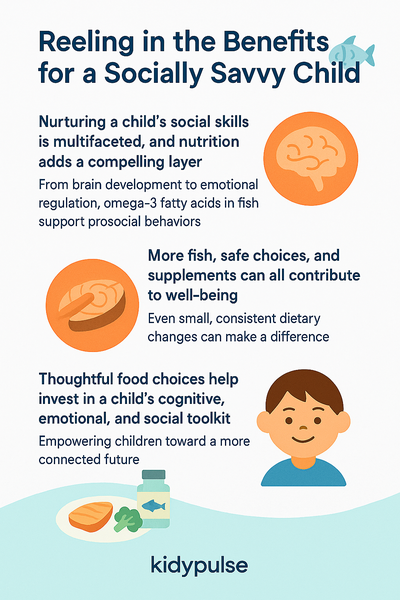
Nurturing a child's social skills is one of the most rewarding aspects of parenting, laying the groundwork for a life filled with positive connections and confidence. The journey to becoming socially adept is multifaceted, influenced by environment, experience, and innate temperament. Emerging evidence now adds another compelling layer to this understanding: the profound role of nutrition, particularly the omega-3 fatty acids found abundantly in fish.
From building the very structure of their developing brains to supporting emotional regulation and focus, these essential fats play a vital role in equipping children with the tools they need to navigate their social worlds successfully. The research linking fish consumption to enhanced prosocial behaviors offers an exciting avenue for parents looking to support their child's interpersonal growth.
Incorporating more fish into a child's diet, choosing safe and beneficial varieties, and exploring alternatives like algae-based supplements for those who don't eat fish, are all practical steps that can contribute to their overall well-being. It's reassuring to know that even small, consistent dietary changes can make a meaningful difference.
Ultimately, by making thoughtful food choices, parents and caregivers are doing more than just filling little tummies; they are actively investing in their child's cognitive, emotional, and social toolkit. This knowledge is empowering, offering another way to nurture children towards a brighter, more connected, and socially flourishing future.
FAQs About How Fish-Rich Diets Enhance Children's Social Skills
- Question:
How often should kids eat fish for better social skills? - Answer:
Experts recommend kids eat fish 1-2 times a week to boost brain health, emotional regulation, and social development. - Question:
My child hates fish. How can I introduce it successfully? - Answer:
Start with mild-flavored fish, mix it into dishes they love, and involve them in meal preparation. Keep offering in different ways—it takes patience, but most children warm up over time. - Question:
What are the safest fish options for children? - Answer:
Salmon, trout, sardines, cod, tilapia, and canned chunk light tuna are great low-mercury choices rich in omega-3 fatty acids. - Question:
How often should children eat fish for noticeable benefits? - Answer:
Studies suggest serving fish once or twice a week offers noticeable improvements in sleep, behavior, and social skills in kids. - Question:
Can omega-3 supplements replace fish in my child's diet? - Answer:
While supplements can help, getting nutrients from whole foods like fish offers additional nutritional benefits. Experts recommend incorporating fish regularly along with a balanced diet. - Question:
How can KidyPulse NutriAI help my child's nutrition? - Answer:
KidyPulse NutriAI offers personalized meal plans, nutrition tracking, and creative meal ideas tailored to your child’s tastes and needs, making healthy eating easier for busy parents. - Question:
What are safe fish choices low in mercury for children? - Answer:
Opt for salmon, sardines, trout, haddock, pollock, tilapia, and light canned tuna, which are all low-mercury options suitable for kids.
Sources:
- University of Bristol – Fish intake linked to better child behaviorsciencedaily.comsciencedaily.com
- American Academy of Pediatrics – Nutritional benefits of fish for developmenthealthychildren.orghealthychildren.org
- University of Pennsylvania – Fish consumption tied to improved sleep and behaviorpenntoday.upenn.edupenntoday.upenn.edu
- Raine et al. – Omega-3 trial showing reduced aggression in childrensciencedaily.comsciencedaily.com
- Dr. Hayley Young – On omega-3 deficiencies and child mood/behaviormedindia.net
- APA/AdventHealth – Healthy diet correlates with better self-esteem and copingadventhealth.com
- AAP HealthyChildren.org – Safe fish choices and guidelines for kidshealthychildren.orghealthychildren.org

Comments
No comments yet. Be the first to leave a comment!